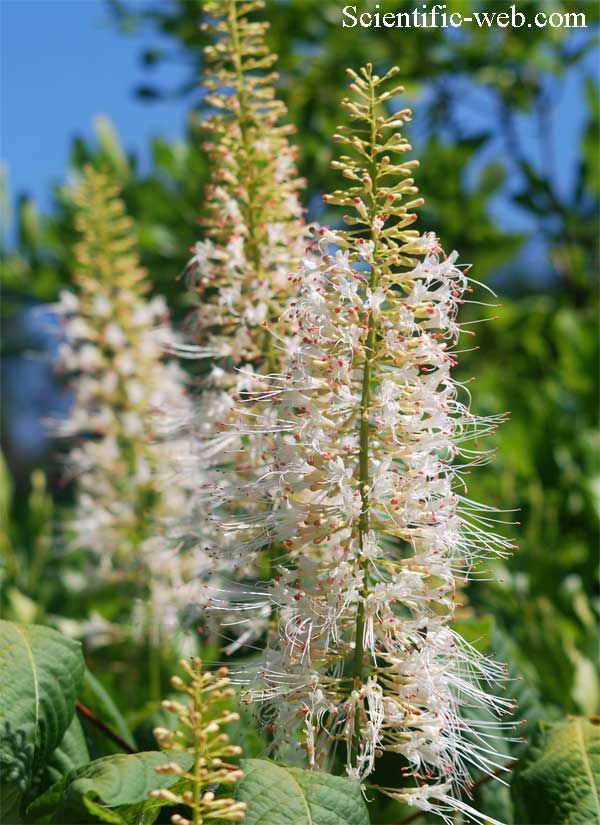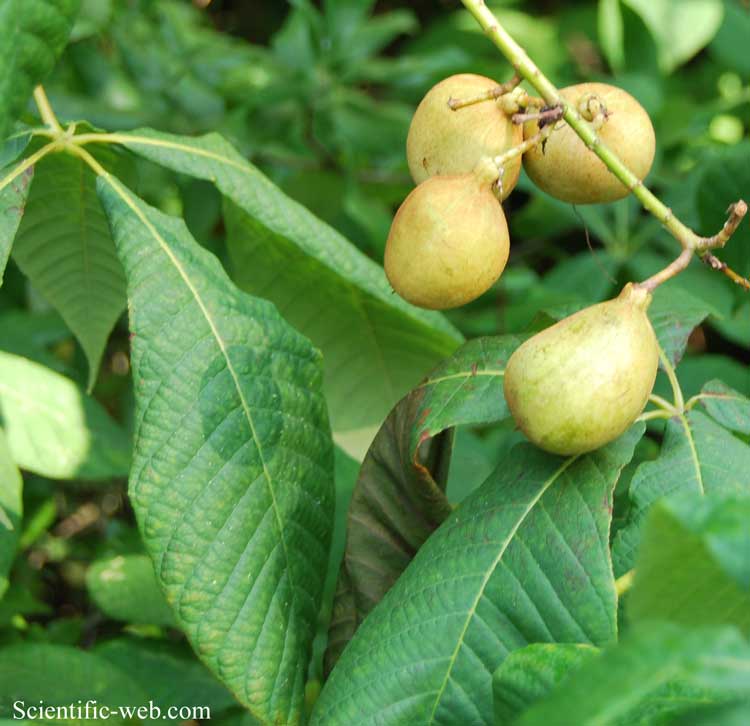
Aesculus parviflora , Photo: Michael Lahanas
Classification System: APG IV
Superregnum: Eukaryota
Regnum: Plantae
Cladus: Angiosperms
Cladus: Eudicots
Cladus: Core eudicots
Cladus: Rosids
Cladus: Eurosids II
Ordo: Sapindales
Familia: Sapindaceae
Subfamilia: Hippocastanoideae
Tribus: Hippocastaneae
Genus: Aesculus
Sectio: A. sect. Macrothyrsus
Species: Aesculus parviflora
Name
Aesculus parviflora Walter, Fl. Carol. (Walter) 128. 1788.
Synonyms
Homotypic
Pavia parviflora (Walter) Raf., Alsogr. Amer. 73. 1838.
Pawia parviflora (Walter) Kuntze, Revis. Gen. Pl. 1: 146. 1891.
Heterotypic
Aesculus alba (Poir.) Raf., Alsogr. Amer. 69. 1838.
Aesculus macrostachya Michx., Fl. Bor.-Amer. (Michaux) 1. 220. 1803.
Aesculus macrostachys Pers., Syn. Pl. (Persoon) 1: 403. 1805.
Aesculus odorata F.Dietr., Lexic. Gaertn. Nachtr. 1. 118. 1815.
Aesculus parviflora f. serotina Rehder, J. Arnold Arbor. 9: 30. 1928.
Macrothyrsus discolor Spach, Ann. Sci. Nat., Bot. sér. 2, 2: 62. 1834.
Macrothyrsus odorata (F.Dietr.) Raf., Alsogr. Amer. 75. 1838.
Nebropsis alba (Poir.) Raf., Alsogr. Amer. 69. 1838.
Pavia alba Poir., Encycl. (Lamarck) 5: 95. 1804.
Pavia edulis Poit. ex DC., Prodr. (de Candolle) 1: 598. 1824.
Pavia macrostachya (Michx.) DC., Prodr. (de Candolle) 1: 598. 1824.
Pavia macrostachys (Pers.) Loisel., Herb. Gén. Amat. 3: t. 212. 1818.

Aesculus parviflora, fruit , Photo: Michael Lahanas
References
Flora Caroliniana, secundum . . . 128. 1788
USDA, ARS, National Genetic Resources Program. Germplasm Resources Information Network - (GRIN) [Online Database]. [1]
Vernacular names
čeština: jírovec drobnokvětý
dansk: Buskhestekastanje
Deutsch: Strauch-Rosskastanie
English: Bottlebrush Buckeye
فارسی: شاهبلوط گلریز
hornjoserbsce: Kerkaty jěrowc
polski: kasztanowiec drobnokwiatowy
slovenčina: pagaštan malokvetý
svenska: Småblommig hästkastanj
українська: Гіркокаштан щітковий
Aesculus parviflora, the bottlebrush buckeye,[3] is a species of suckering deciduous shrub in the family Sapindaceae. The species is native to the southeastern United States, where it is found primarily in Alabama and Georgia, with a disjunct population in South Carolina along the Savannah River.[4][5] Its natural habitat is in mesic forests, on bluffs and in ravines.[4]
This plant is highly poisonous to humans if eaten. Symptoms include muscle weakness, paralysis, vomiting, diarrhea, and death.[6] It has also been reported to be toxic to pets.[7]
Description
Aesculus parviflora grows to 2–4 m tall.[8] The leaves are arranged in opposite pairs, palmately compound with 5-7 leaflets, each leaflet short-stalked, 12–22 cm long and 5–10 cm broad, with an entire margin. The flowers are produced in conspicuous erect panicles 20–50 cm long resembling a traditional bottle brush, each flower with a tubular calyx, small white petals, and several protruding 3–4 cm long stamens. The flowers give way to pear-shaped capsules containing polished, brown seeds.[6]
The Latin specific epithet parviflora means "small-flowered".[9]
Cultivation and uses
Aesculus parviflora is grown as an ornamental plant in gardens, where its August flowering attracts butterflies. It prefers moist, well-drained soils in part shade to full shade. In the US, it is suitable for USDA hardiness zones 4–8.[8]
The naturalist, explorer and plant collector William Bartram first noted this undescribed shrub on his travels through Carolina, Georgia and Florida in 1773–78.[10] An old example was still to be found in Bartram's Garden, Philadelphia, in 1930.[11]
Aesculus parviflora was introduced to British horticulture through the activities of John Fraser, who made his first botanizing trip through the American South in 1785. Fraser's finds were distributed among English nurserymen like Lee and Kennedy or Loddiges or to private patrons, and the shrub was "to be met with in most of our nurseries" by 1820.[12] This plant has gained the Royal Horticultural Society's Award of Garden Merit.[13]
References
IUCN SSC Global Tree Specialist Group.; Botanic Gardens Conservation International; et al. (BGCI) (2020). "Aesculus parviflora". IUCN Red List of Threatened Species. 2020: e.T152911083A152911085. doi:10.2305/IUCN.UK.2020-1.RLTS.T152911083A152911085.en. Retrieved 19 November 2021.
"Aesculus parviflora". NatureServe Explorer. NatureServe. Retrieved 2019-01-22.
USDA, NRCS (n.d.). "Aesculus parviflora". The PLANTS Database (plants.usda.gov). Greensboro, North Carolina: National Plant Data Team. Retrieved 22 January 2019.
Alan Weakley (2015). "Flora of the Southern and Mid-Atlantic States".
"Aesculus parviflora". County-level distribution map from the North American Plant Atlas (NAPA). Biota of North America Program (BONAP). 2014. Retrieved 22 January 2019.
"Aesculus parviflora (Bottlebrush Buckeye) | North Carolina Extension Gardener Plant Toolbox". plants.ces.ncsu.edu. Retrieved 2021-04-07.
"Flowering Plants Non Poisonous to Pets". Home Guides | SF Gate. Retrieved 2021-04-07.
"Aesculus parviflora - Plant Finder". www.missouribotanicalgarden.org. Retrieved 2021-04-07.
Harrison, Lorraine (2012). RHS Latin for gardeners. United Kingdom: Mitchell Beazley. p. 224. ISBN 9781845337315.
Noted by Alice M. Coats, Garden Shrubs and Their Histories (1964) 1992, s.v. "Aesculus"; Bartram's botanizing explorations were recorded in his Travels through North and South Carolina, Georgia, East and West Florida, the Cherokee Country, etc., 1791.
Coats 1992.
Quoted in Coats 1992.
"Aesculus parviflora". Royal Horticultural Society. Retrieved 10 March 2020.
Retrieved from "http://en.wikipedia.org/"
All text is available under the terms of the GNU Free Documentation License

